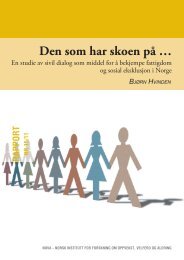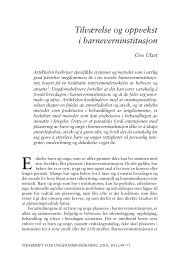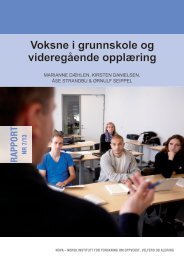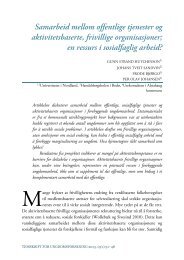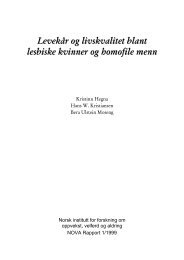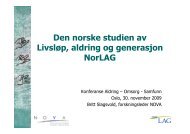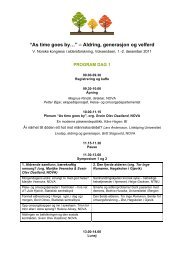Parents' socioeconomic status and children's academic ... - Nova
Parents' socioeconomic status and children's academic ... - Nova
Parents' socioeconomic status and children's academic ... - Nova
You also want an ePaper? Increase the reach of your titles
YUMPU automatically turns print PDFs into web optimized ePapers that Google loves.
The differences in scores are not significant, which confirms the initial<br />
finding by Lauglo (2008). Somewhat surprisingly, those who live with lone<br />
fathers are most likely to get the highest grades, followed by those who live<br />
with lone mothers. The performance of pupils who live with their parents<br />
<strong>and</strong> those who live with step-parents is almost identical. However, the<br />
subgroups are small, <strong>and</strong> the findings are not statistically significant.<br />
4.2 Multivariate analyses<br />
In the previous paragraphs, the effects of some dimensions of parents’<br />
<strong>socioeconomic</strong> <strong>status</strong> on children’s achievement were explored using various<br />
bivariate methods. However, the <strong>socioeconomic</strong> factors affect one another;<br />
hence, in this section some of the analyses are extended using a multivariate<br />
approach.<br />
Linear regression is employed as a tool in these analyses. The model<br />
estimated is: Children’s educational performance (CEP) = g (Education,<br />
mothers’ employment, fathers’ employment, cultural background, gender,<br />
family structure). The null hypothesis is that there is no dependence between<br />
parents’ <strong>socioeconomic</strong> factors <strong>and</strong> the education attainments of their<br />
children.<br />
Most of the variables have been defined above; here, I will introduce the<br />
dummy variable sets of the relevant variables. The model includes only pupils<br />
who reported the results of the three subjects (N=447). The dependent<br />
variable ‘Total’ is the sum of the results of the three subjects Norwegian,<br />
maths <strong>and</strong> English. It is a continuous variable ranging from four to seventeen.<br />
The ‘CASCON’ variable is 1 if the respondent belongs to the case (N=336)<br />
<strong>and</strong> 0 if to the control group (N=101). The gender variable ‘Gender’ is 1 if the<br />
respondent is a girl (N=239) <strong>and</strong> 0 if a boy. The family structure variable is<br />
disaggregated into a set of dummy variables; 1 if the respondent lives with a<br />
lone mother (N=96) <strong>and</strong> 0 otherwise; ‘father’ is 1 if with lone father (N=23)<br />
<strong>and</strong> 0 otherwise; ‘step-parent’ is 1 if the child lives with one parent <strong>and</strong> one<br />
step-parent (N=48). Living with two parents (N=263) is the control for this<br />
set. Educational level, here, is a dummy set for the highest education level in<br />
the household. ‘Basic’ (N=93) is a dummy variable which equals 1 if the<br />
highest education level in the household is the basic level <strong>and</strong> zero if otherwise.<br />
– Parents’ <strong>socioeconomic</strong> <strong>status</strong> <strong>and</strong> children’s <strong>academic</strong> performance – 43




